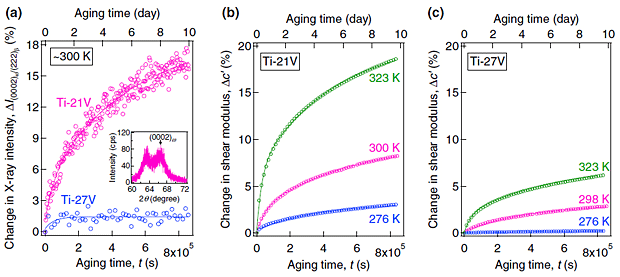In titanium alloys, the ω(hexagonal)-phase transformation has been categorized as either a diffusion-mediated isothermal transformation or an athermal transformation that occurs spontaneously via a diffusionless mechanism. Here we report a diffusionless isothermal ω transformation that can occur even above the athermal ω transformation temperature.
Master alloys with nominal compositions Ti-21V and Ti-27V (at.%) were prepared from high-purity Ti and V via arc melting. Single crystals were grown from the master alloys using a floating-zone method. The prepared single-crystalline specimens were subjected to a solid-solution treatment at 1273 K for 1 h in vacuum and were subsequently quenched in iced water.
Figure 1(a) shows the change in integrated x-ray intensity of (0002)ω in Ti-21V and Ti-27V alloys during aging at ![]() 300 K, where the integrated intensity of (0002)ω was normalized by that of (222)β. In a Ti-21V alloy, the normalized (0002)ω intensity increases during aging at
300 K, where the integrated intensity of (0002)ω was normalized by that of (222)β. In a Ti-21V alloy, the normalized (0002)ω intensity increases during aging at ![]() 300 K. This indicates that ω phase is formed during aging at room temperature (RT). Notably, in the Ti-21V alloy, ω phase is formed above the athermal ω transformation temperature Tω of 230 K. In the Ti-27V alloy whose β phase is more stable, ω phase is also formed during aging at RT, even though the athermal ω transformation does not occur down to cryogenic temperatures.
300 K. This indicates that ω phase is formed during aging at room temperature (RT). Notably, in the Ti-21V alloy, ω phase is formed above the athermal ω transformation temperature Tω of 230 K. In the Ti-27V alloy whose β phase is more stable, ω phase is also formed during aging at RT, even though the athermal ω transformation does not occur down to cryogenic temperatures.
The change in shear modulus Δc′ during aging at 276, ![]() 300, and 323 K is shown in Fig. 1(b) for Ti-21V and in Fig. 1(c) for Ti-27V alloy single crystals. In the Ti-21V alloy, the shear modulus c′ increases during aging at 276, 300, and 323 K, owing to the formation of ω phase with relatively larger elastic constants. The change in shear modulus Δc′ increases with the increase in aging temperature. This indicates that the formation of ω phase is accelerated by an increase in the aging temperature. Similarly, in the Ti-27V alloy, the shear modulus c′ increases during aging at 298 and 323 K, owing to the formation of ω phase. Remarkably, even during aging at 323 K for 10 days, the mean V-atom displacement calculated using its diffusion coefficient is only 6.4
300, and 323 K is shown in Fig. 1(b) for Ti-21V and in Fig. 1(c) for Ti-27V alloy single crystals. In the Ti-21V alloy, the shear modulus c′ increases during aging at 276, 300, and 323 K, owing to the formation of ω phase with relatively larger elastic constants. The change in shear modulus Δc′ increases with the increase in aging temperature. This indicates that the formation of ω phase is accelerated by an increase in the aging temperature. Similarly, in the Ti-27V alloy, the shear modulus c′ increases during aging at 298 and 323 K, owing to the formation of ω phase. Remarkably, even during aging at 323 K for 10 days, the mean V-atom displacement calculated using its diffusion coefficient is only 6.4![]() 10-5 nm for the Ti-21V alloy and 3.9
10-5 nm for the Ti-21V alloy and 3.9![]() 10-8 nm for the Ti-27V alloy. Thus, atomic diffusion could not occur during the present aging processes, but ω phase could be formed isothermally near RT. This indicates that the ω phase is formed via a diffusionless mechanism, i.e., diffusionless isothermal ω transformation occurs near RT. The analysis of atomic diffusion during aging near RT using atom probe tomography measurements also verified that diffusionless isothermal ω transformation occurs near RT.
10-8 nm for the Ti-27V alloy. Thus, atomic diffusion could not occur during the present aging processes, but ω phase could be formed isothermally near RT. This indicates that the ω phase is formed via a diffusionless mechanism, i.e., diffusionless isothermal ω transformation occurs near RT. The analysis of atomic diffusion during aging near RT using atom probe tomography measurements also verified that diffusionless isothermal ω transformation occurs near RT.
In body-centered cubic β-titanium alloyed with β-stabilizing elements such as the V element, there are locally unstable regions having fewer β-stabilizing elements owing to quenched-in compositional fluctuations that are inevitably present in thermal equilibrium. In these locally unstable regions, diffusionless isothermal ω transformation occurs even when the entire β region is stable on average so that athermal ω transformation cannot occur.
